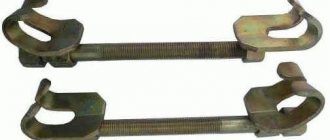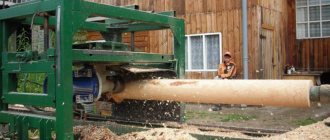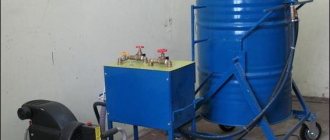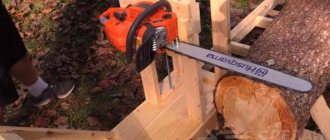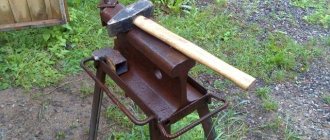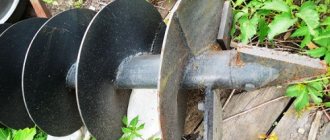Why do you need such a procedure as tightening the shock absorber springs with your own hands? Due to the current circumstances and because of our vaunted domestic roads, it happens that shock absorber units in a car, even an almost new one, fail. And if they are old enough, they wear out from time of use.
Any car enthusiast can carry out these repairs; you just need to have certain skills and an aptitude for using tools. But first we will need a shock absorber spiral tie, and, therefore, a puller to make this work easier.
DIY shock absorber spring tensioner
Quite simply done in a garage. Each shock absorber system includes coil elements called springs. They help withstand the loads during vehicle operation, maintain the proper level of the body above the road surface, and, first of all, in the case of constant increased loads, are subject to wear.
If the shock absorber is in order, but the spring element has failed, worn out, or lost its rigidity, it must be urgently replaced. This operation can be done with a special puller (or in the opposite situation, when the shock absorber needs to be repaired, but the spring seems to be in order).
There are many options for this device. A fairly common one is rack and pinion. It consists of two slats made of metal with threads. There are hooks on both sides that go towards each other when turning. The hooks cling to the spring and produce a tie when the rack rotates. It must be scrolled, and the spiral contracts, freeing up space for inspection.
Alternatively, you can use a belt puller. It requires a pair of “frog” fastenings, they are tucked into fairly strong fabric belts. The belts themselves are threaded into the lower and upper coils of the spring. The “frogs” are squeezed one by one. The belts are tensioned and the spring is compressed.
Without these devices (or their other options, homemade or purchased at a car store), this procedure becomes difficult to complete.
To perform the work, it will be necessary to remove the stands with the device. Place the car, jacking it up and fixing the position (you can put it on special stands made from a block or welded ones - for greater stability of the car).
- Having freed the shock absorber, we proceed to tighten the springs using the puller described above. Regardless of its type and design, we attach it to the lower and upper coils of the spring and begin working with our hands;
- We scroll or work with “frogs” until the part is noticeably compressed. It should be noted that it is not recommended to fully compress the spring. This may increase the risk of failure of either the fixture or the part itself. You need to do everything as carefully as possible, simply releasing the element from the pressure in order to make repairs or change a shock absorber fragment.
Thus, the device itself - the puller - is designed to make life easier for the auto mechanic. After all, without using a puller, the stand would have to be secured in a vice and a lot of force would have to be applied to compress the spring.
It is also necessary that the part be additionally held while you work on the shock-absorbing unit. And with the use of a spring remover, these problems go away, and even one person can carry out the repair in a garage or box. In addition, using this procedure will protect the technician from possible spring failure, practically eliminating it.
Of course, the easiest way is to replace the entire assembly at once. Or, if you have enough free funds, turn to the specialists at the service station so that they can do everything efficiently and on time. But you will have to pay a pretty good price for carrying out repair work of this level. In addition, some car enthusiasts prefer to do any available work exclusively on their own.
These types include various repairs of struts, the main part of which is the shock absorber. And tightening the shock absorber springs with your own hands is a priority task that needs to be solved in such cases.
It can be solved quite simply using a device called a puller. It not only compresses the shock absorber spring, opening access to the necessary repair work. This is also a safe way to tighten the spring without any problems or risk of failure, allowing you to carry out repairs yourself in a garage.
Communities › Garage Equipment and Tools › Blog › DIY spring ties
Hi all. I'm twisting the suspension in places. And you have to change the springs, but this is a rather unsafe task, it can fly into your head and leave you without a finger. But it needs to be done)). And in order to make my work easier, I decided to sculpt a machine for compressing and releasing springs from a Volgov jack (I spotted it on the internet). But after half a day of welding, I realized that mostly in YouTube they compress small springs, which I can easily compress with ordinary ties. Yes, and the plates must be even, otherwise everything will compress awry, and to add to this, my jack was already rickety and did not want to work as expected. What do I mean by all this? And to the fact that after I went PSYCHANIC, I cut up the entire halabuda, and made excellent couplers from the screws of the worthless jacks that would not let me down. And I also rebuilt the factory ones and now they are quite reliable and convenient. What actually happened: Here is a tie from an old non-working jack for Renault 19. The jack is bent, but the screw is reliable. But I made one very necessary upgrade to this device. I added a support bearing to it (the red one in the photo) that was in the jack. That is, if earlier (tested) when you twist the nut, it could bite due to friction, the tie could be pulled to the side and it would naturally fly off, THEN now the support bearing will not allow this to happen, everything will spin like clockwork and the tie will stand dead. The grips are made from a thick chain link, they will never straighten out)))
This is interesting: Selection of Denso iridium spark plugs by car
But what you see in the photo above are seeds compared to this monster. The rod is from a Volgov jack and can withstand two tons. Also with a prop. It works flawlessly, and most importantly, you can compress very large springs, like Mercedes ones - you just need to cut down one more of these for a couple and you will be completely happy.
Well, I modified and strengthened the factory ones (two-legged), with which I had previously worked, and made one-legged ones. Now it copes with the task quite reliably, and does not tend to jump out every time at the slightest misalignment.
All the ties have 24 mm nuts welded on them. I work with a wrench, quickly - and now it’s also relatively safe. These ties have already compressed the two front springs on the Ford Mondeo - without strain.
I haven’t given up on the idea of making a full-fledged stand for compressing springs, I’ll definitely do it, but a little later, when I have free time, the necessary spare parts and inspiration. That's all, good luck everyone. And take care of yourself.
Ps. I made a post in this community, but for some reason it was deleted. Duplicate. Good people, tell me “what’s wrong”? I'll fix it.
DIY rear suspension spring replacement
Rear springs come in two types: assembled with a shock absorber and without it (for example, on Renault Logan). They should also be changed in pairs on the same axis. As with the front springs, it is assumed that the preliminary steps have been completed and the spring is available for removal.
Without shock absorber
1. Raise the rear of the car on a jack.
2. Install the ties on the spring and compress to the desired position.
3. Using a flat-head screwdriver, remove the spring from its socket.
4. Remove the ties, as well as the upper and lower elastic bands.
5. Change the spring and perform the reverse assembly process.
With shock absorber
1. Unscrew the lower bolts of the shock absorber.
2. Jack up the rear of the car (under the rear axle stocking).
3. As you rise, watch the brake hose and the spring, which gradually comes out of its socket.
4. If the lifting height is sufficient, remove the spring and spacers.
5. Replace the spring and shock absorber assembly.
6. When returning it, it is important that the spring fits exactly into the lower recess of the cup.
7. Lower the car body.
8. Tighten the lower bolts of the shock absorber.
If the replacement is carried out correctly, the clearance increases by 6-7 cm.
Source: stolica-atc.ru
Making spring ties from an old jack
Today I removed the strut, it needs to be repaired, but we are not talking about repairing the strut, but about tightening the spring. I’ve seen a lot of different options, everyone makes a VAZ jack from the original one, in my opinion, but I don’t have one, but I have a jack from the Volga GAZ 21, now I’ll try to make a puller out of it. I also needed a couple of corner pieces, a connecting rod from the same Volga, and welding and a grinder.
In principle, what is there to try, I will do it now, for this you need a jack, a connecting rod from a Volga car.
I will continue to do and show what and how...
This is what happened: the connecting rod was welded down,
and on top of this ring I had cut off from a gas cylinder,
this is the ring. Here she is, these are the rings
I have one, I make various products from a gas cylinder and I used it to make a puller.
These are the two segments (I’m not going to the exhibition))) don’t pay too much attention to the appearance.
This is how the puller turned out, now I’ll cultivate it, clean it and spray it a little from a spray can to make it better and show how it works.
Now it will dry out a little because I spray painted it and will try to remove the springs.
This is how the puller for springs from the struts turned out to be so easy to make; it took about 30 minutes to make, which means it was quick to make.
I had to redo the design a little, because the ring that I had prepared at the top was good to disassemble, but assembling it and getting into the shock absorber cushion is difficult, so I had to do it like this.
I didn’t come up with this myself, I spied it and changed it. This is how we compress the spring itself without a cup and structure that stands on top of the shock absorber.
It turned out to be an excellent design, which was tested and proved to be excellent))) Bye everyone.
Author; Alexey Avramenko Cherkassy, Ukraine
How does a spring remover work, and what types are they?
What is a puller used for? It overcomes the straightening force of the springs. The applied force on the puller brackets is commensurate with the weight of the car, but this does not mean that its design is too expensive and high-tech.
There are many options, but they are divided into only two types: mechanical and hydraulic drive.
Mechanical spring remover
Most often it has a threaded drive mechanism.
With a sufficient diameter of the pin (providing a good gear ratio on the thread), and a long handle of the key, you can compress the springs manually without excessive effort.
The technology is as follows: two pullers are symmetrically put on the rack. By turning the threaded rod, you bring the claws to the middle of the spring directly on the shock absorber, compressing it to the required size.
Installing one puller on a spring will cause it to break.
Pullers placed on both sides ensure uniform compression. When working with the suspension of trucks or heavy SUVs, experienced craftsmen install 3 or even 4 pullers.
Correct installation of pullers on the spring
Semi-permanent racks
Service stations often use semi-permanent struts to remove springs from shock absorber struts. The tool is quite universal and fits most pendants. Thanks to the drive mechanism gearbox, working with it is convenient and safe.
The only drawback is that it is not always possible to compress the spring directly on the car. After all, this is a bench device: the puller works with the suspension removed from the car.
Lever type
Lever type pullers have a similar “problem”. The mechanism is reliable and safe, but its dimensions do not allow it to fit into the space under the wing of the car.
Hydraulic puller
Can be portable or stationary. It works on the principle of a jack: there is a main and a working cylinder. By pumping liquid using a lever handle, the operator compresses the power brackets, between which there is a spring.
A compact two-section puller can also become a helper in a home garage, but a floor-mounted stationary machine is only suitable for a car service center.
The hydraulic system is pressurized using a foot lever. At the same time, the car mechanic’s hands are free, working comfortably and safely.
Of course, there are pullers with compressors, electric drives, and other devices that make life easier when servicing a car. This is all good until you see the price tag.
Sometimes it is more profitable to visit a car service center several times than to purchase an industrial puller for personal use. Which exit? Make your own instrument.
How to make a shock absorber spring remover with your own hands
Dear visitors to the “ Samadekin Friend ” website, today we will look at one of the options for making a homemade shock absorber spring puller with our own hands, as well as look at step-by-step photos of assembling the spring puller and a video. Every car enthusiast who has ever repaired the suspension of a passenger car knows perfectly well how difficult it is The shock absorber springs are removed and to perform this operation without a special tool you will have to get pretty clever. But if you think a little and use ingenuity, then a simple shock-absorbing spring remover can be made independently and at minimal cost, so to speak, a simple and budget version of a tool that makes life easier for a motorist.
The design and principle of operation of the presented puller is actually quite simple and understandable; it is based on the compressive force of the spring's screw tie, namely, there are 2 metal hooks installed on the pin that hook onto the spring and, under the influence of tightening the nut, the spring is compressed and then removed from the rack.
So, let's look at what exactly is needed to assemble the puller.
Materials
- metal pipe 16-20 mm
- hairpin M-14
- corner
- nut 2 pcs
- solid oil
Tools
- welding inverter
- drill
- vice
- hammer
- wrench
- Angle grinder (grinder)
Step-by-step instructions for creating a shock absorber spring remover with your own hands.
What is a puller
A puller is a special device that allows compression of shock absorber springs so that repair work can continue in the future. There are many variations of this device, but the most common puller for springs is two metal slats with threads cut along their entire length and hooks fixed on both sides, which, when turned, go towards each other. Those. when you need to compress the springs, you just need to turn the rack, and the fixed hooks will tighten the spring.
There is an even more simplified puller method - a belt puller. In this case, two “frogs” are used with strong fabric belts tucked into them. The belts are thrown onto the upper and lower coils of the springs, then the car owner begins to work with “frogs”, pressing each one in turn. Subsequently, these actions tighten the belts, and the “spiral” begins to tighten, after which repair work can be carried out.
DIY shock absorber spring tie: step-by-step instructions and recommendations
The shock absorber is a unit responsible for a comfortable ride. Often the shock absorber strut requires replacement. For example, it leaked or simply exhausted its resource. In this case, the entire assembly is dismantled. The procedure is labor-intensive, but not complicated. You will need a tool such as a shock absorber spring tie. The device is extremely simple, but at the same time necessary when performing such work.
Required material and tools
To make a screed yourself, you will need a metal rod (reinforcement), two threaded rods (M16), as well as extended nuts and a metal tube with an internal diameter of 16 mm. This will be quite enough to make a full-fledged screed.
This is interesting: Power of attorney form for a car
It is also advisable to have a grinder on hand for cutting reinforcement and several wrenches for the nuts. The set of tools is minimal; all this can be found in the garage of any motorist. Well, now let's take a closer look at the process of assembling the product.
We cook the screeds ourselves
In general, it makes sense to make shock absorber spring ties yourself. How to do this is discussed further.
Four nuts and two threaded rods
The metal products listed below are easy to find in almost any supermarket. For example, you can buy two M16 threaded rods. You will also need four extended nuts, as well as a steel plumbing pipe. Its internal diameter is 16-16.5 mm.
The end result is what is shown in the pictures. You will also need a steel rod, which is used to make reinforcement. Let's look at how screeds are made:
- Two identical cylinders are cut from the pipe, the length of which is 80-120 mm;
- Threaded rods can be shortened if necessary;
- 8 rods approximately 30 cm long are made from reinforcement;
- Using any bending equipment, the rods are bent to obtain hooks;
- Four rods are welded to two nuts, another four - to pipe sections;
- The set of components is completely ready for use at this stage.
It is easier to weld by placing the workpieces on a plane. The essence of these words is illustrated by the picture:
How to weld hook rods
Actually, what follows is a film where the technology is shown “inside and out”. The author even solved the problem with the lack of a bending machine: to bend one rod, you need two similar rods welded to a steel profile.
If the reader thinks that using welding is difficult, then it is better not to take risks. Welded joints can withstand significant loads, but only if they are performed according to all the rules. Spring ties can be made without welding. A suitable drawing is given below.
Two ties in 10 minutes (video)
Making a tie for shock absorber springs with your own hands
Using a grinder, we cut two meter-long pieces from a pre-prepared pipe. We adjust the threaded rods to the required length. Next, we take the reinforcement and mark eight 30 cm sections. We saw it using a grinder and using any bending equipment we try to make hooks from the rod.
Please note that you will also need a welding machine. If you don’t have your own, you can borrow it from a neighbor for a while. We weld 4 pre-cut rods to the nuts, the remaining 4 to the pipe. In principle, we made ties for the shock absorber springs with our own hands and can use them. Let's look at a few more interesting options that are popular among car enthusiasts.
How to tighten a spring
Let's list the steps involved in tightening the shock absorber springs yourself. Everything looks simple:
- When the body is supported by a jack, two ties are brought to the spring from opposite sides;
- By rotating the nuts with your hands, you achieve confident engagement of the hooks and springs;
- Using a wrench, the nuts on different rods are rotated in turn;
- It is better to play it safe and secure the compressed spring with straps or wire.
Video of spring tensioners on shock absorber
No explanation required here. The result is shown in the photo.
When using homemade and even purchased equipment, follow these simple tips:
Before using ties, threaded connections are lubricated with cyatim or grease; The ties cannot be removed from the compressed spring, even if it is additionally fixed; When carrying out work, exercise maximum caution. It is better to sacrifice body parts than your own health. The suspension features of Lifan cars are discussed in these articles:
Features of the suspension of Lifan cars are discussed in these articles:
Shock absorber spring clamp from a jack
There is also an alternative option that does not require special preparation or a large number of tools. To make it, we will need a grinder, a connecting rod from a classic, as well as an old jack from a VAZ (original). The procedure is as follows.
Using a grinder, we cut off the lower support on the jack, as well as the rivets. Next, in the place of the lever for raising/lowering the jack, we mount two ears for the bolts using welding. In the place where the rivets were removed, we weld a piece of pipe measuring 25x25, we do the same in the place of the welded ears, only we take a 20x20 pipe. You can further strengthen the jack with another piece of pipe, cut to the required length. In general, this device for tightening shock absorber springs is quite effective, and it can be made quite quickly without much expense.
DIY device for disassembling racks - Metals, equipment, instructions
When repairing or adjusting a car's suspension, it becomes necessary to fix the spring in a certain position. There is a service tool for this work: a spring remover, with which you can remove chassis elements both in a specialized workshop and in a garage.
Various tool concepts:
- Passive: Consists of two brackets connected to each other either rigidly or using a threaded rod. It simply secures a spring compressed using the weight of the vehicle. After lifting the body with a jack, the elastic element remains in a compressed state.
- Active: The compression mechanism can operate under load when the shock absorber is under operating tension. The position of the body relative to the ground does not matter.
Let's consider the second option in more detail.
What you need to know when dismantling
Tightening car springs is a rather dangerous process. If you make a low-quality puller, it may come off. The high pressure puts you at risk of injury. That is why it is necessary to be extremely careful when performing such work.
To prevent anything from happening, you can make a stationary screed. Its design does not differ from that described above. The only change is the rigid attachment to the tabletop. This will ensure that the shock absorber spring tie is securely fixed, which will significantly reduce the risk of injury. Now let's look at another popular and extremely effective design.
Device for removing springs from car shock absorbers
For convenient, quick and, most importantly, safe removal of springs from car shock absorbers in a garage, it is best to use special devices (racks) that will make the work easier.
Factory models are not cheap. And why overpay if there is always an alternative option? For example, you can make your own homemade device for removing springs from a mechanical jack.
The first step is to lengthen the jack stand by 2-3 times. To do this, the master first cuts off the supporting “penny” and welds a piece of profile pipe of the required length to the rack.
Main stages of work
Then the base of the jack will need to be welded to the bottom of the profile. Next, a flywheel is welded to it (it is advisable to choose one so that the internal hole is slightly larger in diameter than the supporting part itself).
Next, using a grinder, you need to cut off the standard hook on the jack, and instead weld a U-shaped part welded from pieces of the profile.
Then at the top of the jack you will need to make another hook, but from a metal plate 7 mm thick.
In principle, the hook in the lower part can also be made of thick metal - then the structure itself will be more reliable.
Then all that remains is to clean the device with a grinder and paint it. We recommend watching a more detailed process of manufacturing a device for removing springs from car shock absorbers in the video on our website.
Rate this post
Source: https://sdelairukami.ru/ustrojstvo-dlya-snyatiya-pruzhin-s-amortizatorov-avto/
Simple and affordable
We take two rods of equal length. The thread can be any, but it is most convenient to use standard M16 or M18. The rod must have two threads: on one side - left, on the second - right, or vice versa. It is advisable to firmly fix the elongated nut in the center as a limiter. There are such commercial rods, so if there is no special machine for cutting threads, we go to the car market.
All that remains is to weld a few hooks onto the nuts - and you can use them. To make the device work more smoothly, it is advisable to lubricate the thread and nut. You can use regular machine oil or grease. Here it is necessary to achieve smooth operation; almost any lubricant will do. You can also use the drawings and take them to a turner, who will do everything. A shock absorber spring tie is made in a few hours.
Drawings of universal threaded ties
Let's return to the question of how to make a device for tightening shock absorber springs yourself. Below is the appearance of the finished devices:
Factory-made threaded ties
On one side of the rod there is a left-hand thread, on the other - a right-hand thread. The standard thread pitch is M18. But buying threaded rods is not enough here. And to cut the thread yourself, you will need special equipment.
Read also: How to remove a video disc from an angle grinder
Drawings of the components that make up the entire structure are shown here:
Threaded tie (3 parts)
To make parts, you need a lathe, drilling and, probably, milling machine. It may be easier to contact a workshop. Print the drawing by downloading it from the website.
Most likely, there are no other drawings of universal ties on the Internet. And what is shown above is taken from a book on repairing domestic cars. You can use it.
Let's say the ties were made according to the drawings and all the parts fit together. But even then the advice about using lubricant remains valid. You need to take solid oil or cyatim and apply this material to the threads of the nuts.
Cyatim-201 lubricant is a rather expensive material. You can reduce consumption by mixing it with machine oil in a 50/50 ratio. Good luck.
can I wedge in? If the puller is in the form of separate 2-3 staples, then it’s not fun. The staples have a bad tendency to slide along the coils of the spring all in one direction, the spring bends in an arc, like a shot, and where it will fly after that and on what fingers it will hit the head is unknown. I squeezed the spring and placed it next to the car, I turned behind the car, at that moment it shot and jumped above the roof of the house, I pressed my head into my shoulders and waited for where it would fall: on my head or the roof of the car, it fell on the barn.
I use this method: I make a hole in the ground 5-10 cm, put a stand in it, put on a spring, an upper cup and press it all down. drawbar from a loaded trailer (like “through a lever”). With a 10 year old boy, it takes 5 minutes.
Well, I’ll add))) I compressed it in a lathe. You press the spring against the cartridge, move the tailstock, lock it, and then use the lead screw to compress it. Then you tie it and remove it from the machine.
Read also: What is the accuracy class of a measuring device
cool :)) The guy advised me to buy a puller for 100 rubles. I - get two Zhiglov jacks and wire. You find a trailer, load it with something, dig a hole in the asphalt and take an assistant.
Logically, the next advice would be to contact the service :))))
